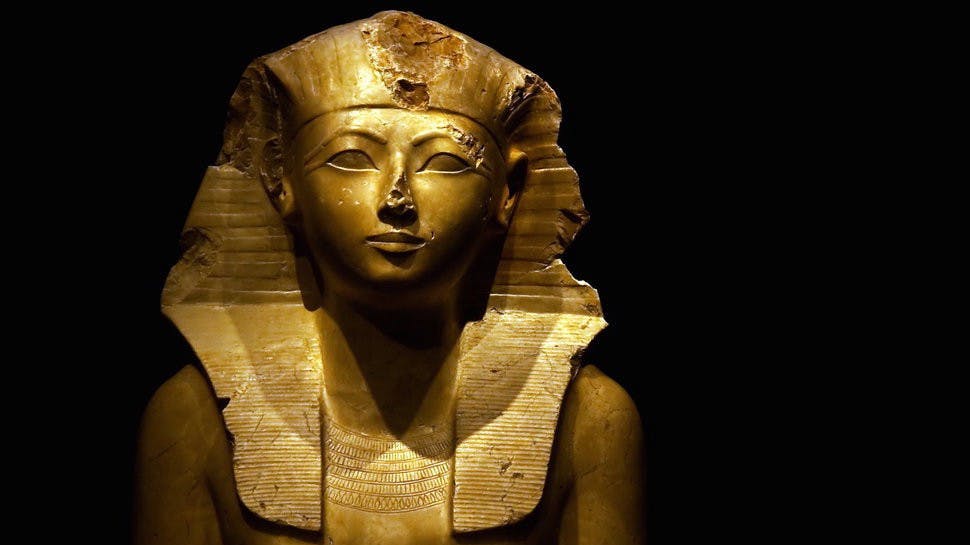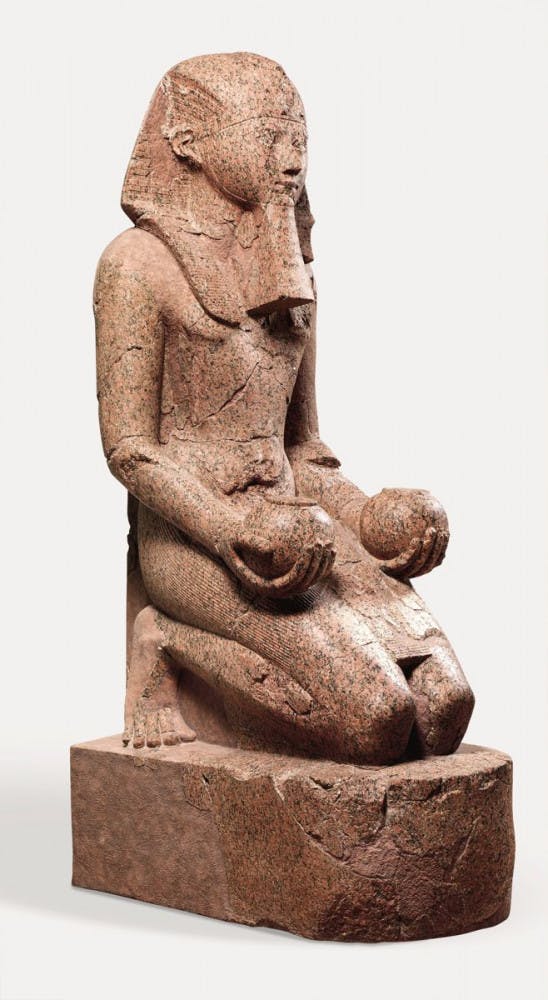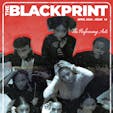BY: NOOR SULLIVAN

Statue of Hatshepsut
Egyptians, Africans, feminists, anthropologists, historians, listen up.
Hatshepsut is often described as a female Pharaoh from the 18th dynasty. She is often touted as a figurehead of women in power in antiquity, but Hatshepsut wasn't a woman. She couldn't have been. The word "woman" didn't exist, and that matters much more than many of us seem to think it does.

Doorway from Hatshepsut's Deir El-Bahri temple By Noor Sullivan
Calling Hatshepsut a woman requires projecting today's specific contemporary conception of not just gender's language, but also its components. The most professional projections we'd have to make are that she had a gender and that it was fundamentally linked to her visible anatomy – which to assume womanhood would be, if visible, a vagina and breasts that seem capable of lactating. If you're already wincing, hang on because it gets worse.
Translation is not a neutral act. The first word in Matthew Ward's English translation of Albert Camus' L'Étranger (The Stranger) remains intact because "maman" fills a specific, culturally situated role, distinct from the English terms "mother" or "mom," that alteration would meaningfully distort. This argument is so graspable because a lot of people globally still speak French and English and use the word "maman," so they can feel the differences. Since all these people are still alive, we can, in a sense, just ask around.
But Hatshepsut is super dead – dead thousands of years over – and so are her immediate contemporaries, so we can't ask any of them. Instead, we have to examine what's left of their lives, figure out how they conceived of themselves and, specifically, her. With all that data, Hatshepsut's womanhood is an exceedingly tough sell.
This facile approach quickly crumbles because her own representations of herself are not consistent with a strict cissexist framework of womanhood. Some Egyptologists are inclined to argue that the false beard is more a mark of her office than a statement about her gender. That's conceivable, but we still have to account for other depictions such as the Pharaoh pictured shirtless with chiseled pecs.

Statue of Hatshepsut from The Metropolitan Museum of Art || ca. 1479–1458 B.C
When faced with Hatshepsut's using what had been translated as masculine language in texts representing herself as the Pharaoh, still other specialists offer that her womanhood is more ‘real' than whatever interpretable manhood those words may suggest. Some scholars argue that the pharaoh was fundamentally a man's office, so the language simply didn't exist to accommodate a woman's holding it. Never mind that Hatshepsut was a divine ruler borne of Amun whose monumental legacy survived decades of attempted erasure from her successors. Pronouns, apparently, were just too far out of her jurisdiction. It is a distinctly cissexist imagination that collects all the documentation and representations of Hatshepsut and contorts itself like this in a search for her ‘real' womanhood.
The root of the problem is as Rosemary Joyce wrote in her book "Ancient Bodies, Ancient Lives": "the two-sex/two-gender model itself is a historical product of particular times and places. We can force the data into the model, but there will always be contradictions as a result."
We are getting caught specifically in the anglophone – sometimes French or German – model characteristic of industrialized Europe, modernity, and contemporary globalization. Too many of us are stuck in the language of wo/man and fe/male. Too many of us are grasping desperately for direct translations of deeply nuanced, historically and culturally situated social concepts and experiences, and it is clouding our judgment. It is as likely that Hatshepsut and any of her contemporaries were women or men as it is that any of them spoke English. Claiming that any of them were men or women requires centering a worldview so infinitesimally specific and short-lived that such claims are transparently ludicrous.
When we try to understand how Hatshepsut and her contemporaries, or anybody who is dead, organized and embodied meaning in their lives, it is not our job to hunt for evidence of what we do now in what they did then. It is not our job to find men and women in history. Our task is to work towards reconstructing the terms on which the people we're curious about lived. What I'm saying isn't new. Fine-grain definitions of concepts that are not quite translatable into English are abundant, including within Egyptology. The Ebers papyrus references at least six kinds of yeast, which specialists have willingly differentiated from each other in their translations.
Some scholars are trying to change — at least kind of. In Malayna Evans Williams' 2016 dissertation, Signs of Creation, she investigated how cosmogony interacted with what we now recognize as gender and sex models in ancient Egypt. It is a nice example of trying to work from the inside out more than retrospectively, but she still relied on the language of wo/man and fe/male, even when handling documents that explicitly flout that framework – namely representations of deities with ‘mixed' sexual characteristics.
Here, again, Joyce's analysis of the state of archaeology, that "the reliance on the very vocabulary of a two-sex model guarantee[s] reproduction of the model," applies. Williams didn't need to look for women and men, or males and females, at all. Those analytical categories aren't useful when people don't already use those words to describe themselves. Insisting upon them will always lead to frustration and confusion when the evidence inevitably fails to neatly conform to them. Separating gender from sex in some ceremonial way isn't enough.
We have to accept that women and men do not necessarily exist where people don't call themselves those exact words. "Wo/man" and "fe/male" are already socially and scientifically insufficient for anglophones. To trample across the world wielding that vocabulary like it's supposed to work flawlessly for every community in every time is to disregard nuance transparently and irresponsibly. We lose more than synonyms in this behavior. We wouldn't do it for something as unassuming as the difference between "mom" and "maman." We shouldn't do it for things as massive as entire genders.


